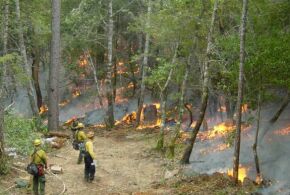‘Therapy Dogs’ Help Relieve Stress for Families
By Rudi Williams
American Forces Press Service
ARLINGTON, Va., Oct. 11, 2001 — “Wow”! “Look at the dogs!” Melvina Brown, 5, exclaimed as she rushed to pet a “therapy dog” at DoD’s Family (Casualty) Assistance Center here. Her little brother, Robert Russell III, 2, eagerly followed.
Later, Kelli Lynch, 2, stunned her father by petting the dogs.
“I didn’t realize what they were here for until my daughter started playing with them,” said Paul Lynch of Waldorf, Md. “She doesn’t have a dog. She’s actually terrified of them, so it’s surprising that she’s playing with these dogs.” Tears started streaming down his cheeks.
“My father has two dogs at the house, and anytime either one of them makes a move toward her, she turns around and runs and screams and cries. But she’s petting these dogs right now,” Lynch said.
His father, James Lynch, was a civilian employee in the Navy Command Center at the Pentagon. His office was in the direct path of the hijacked airliner that crashed into the building on Sept. 11.
The therapy dogs, a variety of breeds, gave tail-wagging greetings to anyone who entered their space. The four- footed therapists are part of Therapy Dogs International Inc., a volunteer organization that provides qualified handlers and their dogs for visits to hospitals, nursing homes and other places where the dogs might help make residents and patients smile.
Group officials pointed out researchers have clinically proven that petting, touching and talking to the animals lowers patients’ blood pressure, relieves stress and eases depression.
“We’re here at the family assistance center for the families, volunteers, staff, military, security — everybody,” said Sue Peetoom of Fredericksburg, Va., chairwoman of the group’s local chapter, Spirit keepers. “We have our dogs available at any time to be petted and hugged for comfort for the families to remember the pets they’ve left at home while they’re here.”
“The dogs are like a magnet, people are just drawn to them,” said Peetoom’s husband, Lee. “A lot of families, counselors, clergy and other members of support groups stopped by to pet the dogs. We also took them to the kids rooms where children were kept while the parents were taking care of business.”
“We were asked to come here because we have a chapter in Oklahoma City that helped people dealing with the disaster there,” Sue Peetoom said.
Certified therapy dogs must be trained, tested and evaluated before they’re allowed into action, she noted.
“They must be ‘bombproof,'” she said. “That is, they can’t react adversely to any situation. They have to be able to be pulled, prodded, hugged, in large crowds, loud noises. They have to be able to deal with anything that happens to them. We have dogs of all shapes, sizes, breeds — and mixed breeds. The only requirement is that they have to be a year old and have excellent temperaments, love people and get along with other dogs, because we’re always in groups.”
They’re all family pets of the people on the other end of the leash, she noted.
A steady stream of people visit the dogs every day, Peetoom said. “We have dogs in the lobby, upstairs, in the children’s room. The dogs are not only for the families, though. Everybody working here is stressed as well, and they’re coming by just for a minute or to smile, touch the dogs, decompress and go back to work.”

Robert Russell III and Melvina Brown had a ball playing with the therapy dogs at DoD’s Family (Casualty) Assistance Center in Arlington, Virginia.
Photo by Rudi Williams.

 Fire crews continue to snuff out burning fuels around the 21-mile perimeter of the Swillup Fire, while the remaining fuels in the middle of the 8,300-acre fire area continue to actively burn. Over the course of the last few days, westerly winds have been moving smoke into portions of the Klamath, Scott, and Salmon River Valleys. According to Happy Camp District Ranger Michael Condon, “The smoky conditions are likely to persist for several days. Afternoon winds will increase fire activity over the next few days, as the fire continues to burn on the east side of Swillup Creek. Even though most of the firefighters have returned home, we have more than enough firefighters still assigned to the fire to keep the fire contained while mop-up continues.â€
Fire crews continue to snuff out burning fuels around the 21-mile perimeter of the Swillup Fire, while the remaining fuels in the middle of the 8,300-acre fire area continue to actively burn. Over the course of the last few days, westerly winds have been moving smoke into portions of the Klamath, Scott, and Salmon River Valleys. According to Happy Camp District Ranger Michael Condon, “The smoky conditions are likely to persist for several days. Afternoon winds will increase fire activity over the next few days, as the fire continues to burn on the east side of Swillup Creek. Even though most of the firefighters have returned home, we have more than enough firefighters still assigned to the fire to keep the fire contained while mop-up continues.â€